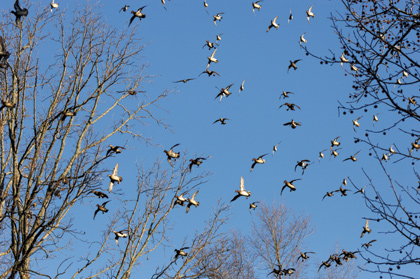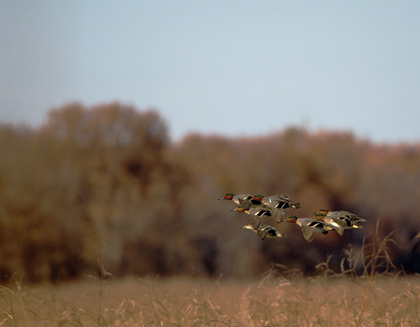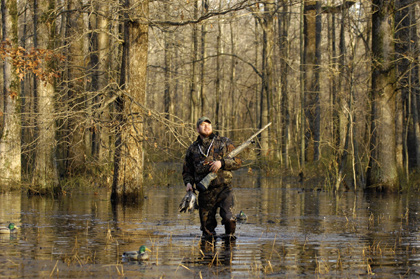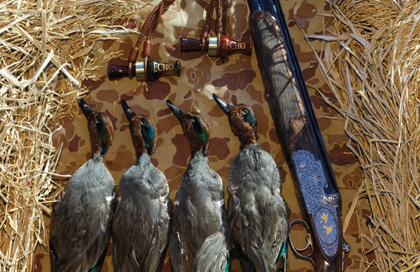November 03, 2010
By Jim Daniel
Working Big Flocks of Speedsters In Arkansas' Flooded Forest.
By Jim Daniel
Advertisement
Advertisement
 |
The Hunt
This morning, early in the 2006-07 Arkansas duck season, Rusty reminded us to be ready for teal zipping into and out of the timber holes. "This year we're seeing an unusually large number of teal, so there must have been a good teal hatch up north," he said. He explained teal are "bonus" ducks since the Arkansas limit allows four mallards but six ducks total. But visions of big fat greenheads fluttering down through the trees made it awfully hard to think about tiny teal.
The strategy was to hunt both the Gar and the Doughnut holes. Harvey Robbins, our host, encouraged us to "make your final pit stops" and the group complied and soon assembled in the ready room. At Harvey's the ready room resembles an NFL locker room with individual stalls for guns, equipment and waders. It is called the ready room because one gets ready for world class hunting going out and world-class camaraderie and food coming back in.
We descended the lodge steps and walked the short distance to the boathouse where the Mercury outboards were already warming up. Harvey's group plus Micah's wonderful retriever Safire loaded into the "Queen Mary", a large covered flat bottom, powered by a 60 HP Mercury. Rusty and three of us spread out in one of the open flat bottoms.
Seconds later we were running flat out down a canal in the mild pre-dawn darkness. The vibration had lulled me into a quiet reflection on how lucky I was to be hunting this place, when Rusty jumped the rig across a patch of dry ground from one levy canal to another without as much as a hiccup. The outboard whined until the prop was underwater again, but we never missed a beat. It sure got my attention, but Creasey is one of the best guides anywhere, so I didn't worry. I didn't have time to because it happened so fast.
As we sped through the darkness without the aid of a light, I couldn't help but wonder how Rusty would know where and when to leave the canal for the Doughnut hole. Moments later Rusty, still running full speed, turned sharply into the timber darkness and followed a narrow "boat trail" to the hole. Only when we approached the hole did he throttle the motor down. "We're there," Rusty announced. So we gathered guns and gear and eased into the knee-deep water. For some it may have been one of their most "exciting" boat rides ever. But what the heck, mallards awaited us.
Before hiding the boat in the timber, Rusty pointed to where he wanted each of us. There was a gentle northeast wind so we set up facing it in the rectangular 50- by 25-yard patch of open water in the trees. The Doughnut hole gives ducks a long entry glide path from several directions. Ringing the opening are giant Sweet gum and Oak trees with buck brush growing in their shadows. It's easy to see why the ducks prefer the spot once you see the cover and flight patterns into it.
 Cruising... |
Harvey's has ducks when no one else in the region does because of their sanctuary. It consists of a huge willow break with all kinds of shadow filled "hidey holes" where the ducks can loaf and congregate without being disturbed-ever. Only the fringes of this rest area are ever hunted, so the ducks quickly become accustomed to it providing an escape from the continual gunning pressure elsewhere. Most of the ducks we were now seeing above the hole were actually heading for the sanctuary.
Decoys and a jerk string were already in place, so there was little for us to do other than to stand ready with unloaded guns until legal shooting time arrived.
Rusty disappeared into the darkness trailing the boat behind him. Already the sky above the timber was filled with mallards coming in from a night of feeding in the adjacent rice fields. Ducks were everywhere, flying in all directions, little groups, big groups, pairs and more. From what we could tell, most were "big ducks" mallards with a few gadwalls mixed in. Rusty's teal had thus far failed to materialize.
In this predawn twilight six ducks lit among the decoys and swam off into the timber. Then a pair of mallards did the same thing at the other end of the hole. A big greenhead lit in front almost splashing water on me. He immediately realized his mistake and with a whoosh and squeaking wings he was airborne again. Clearly, it was going to be on in the Doughnut hole this morning. But at the moment, all we could do was watch the spectacle. Still no teal.
 On the lookout for more speedsters. |
Rusty, after hiding the boat, reappeared out of the darkness and began to issue a low feeding call. He hung his Beretta by a plastic zip string on a limb and began to operate the jerk string while calling to one group of ducks after another. Decoys across the spread began to bob and dance making ripples in the water. We added to them by creating loud splashes in the water with our legs. Tradition says this simulates the fuss large groups of ducks sometimes make in timber.
Most groups sailed by heading for the sanctuary and the multitudes of ducks already convening there for the day. However, Rusty would occasionally "hook" a group that would turn and begin to work. Around and around the hole they would circle looking, listening and looking some more. The pull of hundreds of live ducks close by made our ruse a hard sell, but eventually some liked what they saw and heard and set up to come in. Then Harvey's group in the Gar hole group announced legal shooting hours with a barrage of many shots. Sounded like a big group committed early on. Perhaps it was a group of teal, I thought.
Ducks In The Hole
Our first group into the hole came directly down the flight path right into our faces. As the three drakes and a hen hung almost helplessly in the air, just feet above the decoys, Rusty called the shot with the birds 20 yards away. All four fell lifelessly into the decoys. Each shooter quickly retrieved his duck and returned to hug his tree while Rusty kept up the calling and operated the jerk cord.
Because my appointed spot was next to Rusty, I had the opportunity to observe how he calls ducks. There is a fine art to timber calling and he has mastered it completely. Often it is difficult to observe called ducks as they "work" a hole. If one ca
lls too loudly or at the wrong moment those wise old hens "bust" you immediately and the birds flare. Knowing when to call and when to remain quiet is extremely important. Rusty is well taught and works birds in a very seductive and realistic manner that produces results. He pleads loudly with ducks going away and once they turn he lowers his volume and reverts to a "tuk-a-tuk" feed call to instill confidence in the birds. Once the birds commit and are at tree top level, the calling stops with only an occasional "tuk-a-tuk".
A lone drake decided to stop in and went down very much alive. With his head up straight the drake rapidly swam toward the deep timber. Rusty dropped the jerk string and in a flash was across the hole in hot pursuit while the rest of us watched the drama unfold. When the distance closed within "swatting" range, Rusty dispatched the greenhead and headed back holding the duck by the bill. The rising sun was full on his smiling face. It was very clear, Rusty loves his work.
Increasing daylight made fooling the ducks harder. Competing with large numbers of birds already down in the timber is a very difficult task. Again and again we would have groups of six to ten birds begin to work only to have them break off and glide into the sanctuary. This went on for an extended period and then the sun began to hit the decoys. Sun on the decoys markedly increased our odds of pulling birds into the hole.
First there was a pair, then a group of seven followed by a single hen, which we passed on. Rusty called for a count of birds. We had 15 mallards with two "accidental hens" in the count. "One more bird and I'll call in our breakfast orders," Rusty said. Almost a limit and no "bonus" ducks, I thought to myself while feeling disappointment that the fun was ending too soon.
"Big ducks" were coming and going in and out of the sanctuary, so our hole had continuous traffic overhead. Usually the ducks wouldn't respond to the call but every now and then Rusty enticed some "workers." But most were passing "lookers." Three circled and circled and finally decided to do it. When they got down below the trees we recognized all were hens. Ten feet before splashdown they flared on out into the timber rather than lift back up.
Up to this point our hunt had not included even one teal. There was no indication we were about to experience something very unique, perhaps never experienced in flooded timber hunting. Besides, why would one having almost a "perfect" mallard hunt be thinking about teal anyway? I, for one, knew from countless fruitless and labor-intensive days roaming the Cache River in search of mallard "hidey holes" how lucky I was to be hunting at Harvey's.
Stomachs had started to growl, but we needed one more mallard.
 Four beauties gunned from the timber. |
Then it happened. A large group of green-winged Teal rocketed by just above the trees, barreling toward the sanctuary. They resembled a huge swarm of bees. Rusty hailed them with a shift in tone and sound, but they had already made up their minds and were instantly gone twisting and turning over the trees. We talked around the hole about how none of us had ever seen such a large group of teal in flooded timber.
This discussion was still going on when Rusty announced, "Here they come again." Sure enough the teal evidently had only landed briefly in the sanctuary and were airborne again buzzing open areas in full force. The group diagonally buzzed the Doughnut hole. They had the afterburners on and there was only enough time to watch as they disappeared through the trees.
Again, the teal roared back and were already on short final into the hole. It was so sudden and beautiful no one fired a shot. Instead of heading back out into the timber the teal rose just above the trees and once again set up in the flight pattern. Rusty whispered, "They're coming back, this time be ready."
I quickly pre-focused my camera on a tree top limb exactly at the beginning of the main entry point of the glide path into the hole hoping to be lucky enough to capture an image or two of this barreling beehive.
Within seconds the viewfinder was full of teal, wings vertical to the ground, turning the corner in unison. Instantly the camera locked on and I ripped off a couple of eight frames per second bursts. Literally, our hole was filled with cupped wing, feet down teal in every possible configuration of landing positions possible. The beauty and excitement of the scene was enough to overwhelm even the most insensitive and hardhearted person.
Then, the real shooting began. Eight Green Wing teal were downed with only one a hen. We had done high percentage shooting in the midst of a high-speed situation. Later, my images showed 92 teal in every kind of landing position imaginable dropping into our hole. The significance of it all didn't completely dawn on us until later when we reviewed the pictures.
Conclusion
Yes, we'd enjoyed a premier flooded timber hunt with almost a limit of big, fat, rice-fed mallards.
But the day was about much more. Witnessing over one hundred aerial acrobats rocketing into our flooded timber hole and the shots that followed will forever be etched in our minds. Yes, it was a Timber Teal day.

